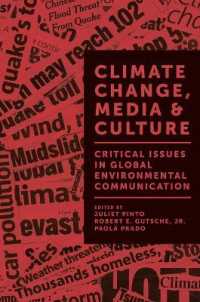基本説明
Offers a range of perspectives on risk and risk communication.
Full Description
Controversies about risks to public health regularly hit the news, whether about food safety, environmental issues, medical interventions, or "lifestyle" risks such as drinking. To those trying to manage or regulate risks, public reactions sometimes seem bizarre. To the public, the behaviour of those supposedly "in charge" can seem no less odd. Trust is currently at a premium.
This new edition of Risk Communication and Public Health covers the theoretical and research background, and presents a wide range of contemporary case studies and the learning experiences from these, and the political, institutional and organisational issues they raise. It concludes with an analysis of the lessons learned and gives pointers for the future. The book offers international perspectives, and contributors include representatives from consumer organisations as well as public health practitioners and academics. This edition is substantially updated with new material and case studies, but retains the same focus - the improvement of communication and promotion of "good practice" in risk communication, in Government, the Health Service and elsewhere.
This second edition presents a broad view of the issues around risk communication and public health in a way that will be of interest to a range of public health practitioners, managers and policy makers, postgraduate students and academics in a number of disciplines, and those interested in environmental health.
Contents
PART 1: RISK, COMMUNICATION AND THE PUBLIC UNDERSTANDING OF UNCERTAINTY IN PUBLIC HEALTH ; 1. Understanding public responses to risk ; 2. Bringing light to the shadows and shadows to the light: risk, risk management and risk communication ; 3. Consumer perceptions of the risks and benefits associated with food hazards ; 4. The social amplification of risk framework (SARP): Theory, critiques and policy implications ; 5. From trouble to trauma: the need for public-private health partnerships ; PART 2: PUBLIC HEALTH RISK COMMUNICATION IN PRACTICE ; 6. The role of the media in public health crises: Perspectives from the UK and Europe ; 7. Where do we go from here? The evacuation of city centres and the communication of public health risks from extreme threats ; 8. Radiation in London: managing risk communication in the Litvinenko affair ; 9. Risk Communication in the British Pertussis and MMR Vaccine Controversies ; 10. Risk communication and pandemic influenza ; 11. CJD: risk communication in a health care setting ; 12. Contesting the science: public health knowledge and action in controversial land-use developments ; 13. A Precautionary tale - the role of the precautionary principle in policy making for public health ; PART 3: FROM THE INSIDE LOOKING OUT, LOOKING IN - ORGANISATIONAL ISSUES AROUND PREPARATION AND RESPONSE FOR PUBLIC HEALTH RISKS ; 14. Changes to food risk management and communication ; 15. Communicating across publics and between organisations: the case of childhood accidents ; 16. Exporting Pandora's Box - Exploitation, risk communication and public health problems associated with the export of hazard ; 17. Communication about persistent environmental risks: problems of knowledge exchange and potential of participative techniques ; 18. Geographical information systems as a means for communicating about public health ; 19. Exploring and Communicating Risks: Scenario-based workshops ; 20. Embedding better practice in risk communication and public health








